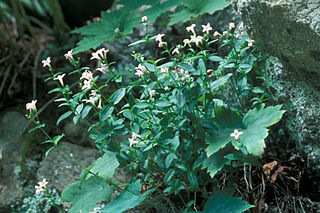
The arroyo bluet is a damselfly of the family Coenagrionidae, native to the western United States, south to southern Mexico. It is associated with slow-flowing streams or lake margins with emergent vegetation.

Houstonia caerulea, commonly known as azure bluet, Quaker ladies, or bluets, is a perennial species in the family Rubiaceae. It is native to eastern Canada and the eastern United States. It is found in a variety of habitats such as cliffs, alpine zones, forests, meadows and shores of rivers or lakes.
Bluet or bluets may refer to:

Enallagma is a genus of damselflies in the family Coenagrionidae commonly known as bluets. Adults range in length from 28 mm to 40 mm. Males are usually bright blue and black while the coloration of females varies by species. Bluets can be distinguished from the similar vivid dancer by wing position; at rest, bluets' wings hang down on either side of their body, while vivid dancers hold their wings above their body. Bluets also have shorter leg spines.

Houstonia (bluet) is a genus of plants in the family Rubiaceae. Many species were formerly classified, along with other genera since segregated elsewhere, in a more inclusive genus Hedyotis.

Coenagrion is a genus of damselflies in the family Coenagrionidae, commonly called the Eurasian Bluets. Species of Coenagrion are generally medium-sized, brightly coloured damselflies.

Houstonia longifolia, commonly known as long-leaved bluet or longleaf summer bluet, is a perennial plant in the family Rubiaceae. It can be found throughout most of the Eastern United States and Canada. It has been reported from every state east of the Mississippi River except Delaware, plus North Dakota, Minnesota, Missouri, Arkansas and Oklahoma, with isolated populations in Kansas and Texas. Also, all Canadian provinces from Quebec to Alberta. It prefers upland woods in poor, dry, often sandy soil.

The double-striped bluet is a species of damselfly in the family Coenagrionidae. This species grows to lengths 21–28 mm. Its common name from the peculiar black shoulder stripe, which is divided in two by a thin blue stripe. This is the key identification characteristic; no other damselfly has a shoulder stripe that looks like this one.

The stream bluet is a species of American bluet damselflies in the family Coenagrionidae. Its length is 29–37 mm. Many bluet species prefer ponds and lakes; the stream bluet as its name implies is most at home along moving waters. It can be found along small to medium-sized rivers. It is occasionally found at lakes too. In many species of damselflies the males have a blue tip to the abdomen. Enallagma exsulans is one of those less common cases where the female, too, has a blue abdominal tip. Summertime is the best time to look for stream bluets.

The boreal bluet is a species of damselfly in the family Coenagrionidae.

Enallagma traviatum is a species of small damselfly in the family Coenagrionidae. It is commonly known as the slender bluet. The slender is small about 29–32 mm in length.

Enallagma annexum, the northern bluet, is a species of damselfly in the family Coenagrionidae. Enallagma annexum was formerly included with Enallagma cyathigerum.

Houstonia purpurea is a species of flowering plant in the coffee family known by the common names Venus's pride, woodland bluet, and purple bluet. It is native to the eastern United States from eastern Texas and Oklahoma east to Florida and Pennsylvania, with scattered populations in Nebraska, Iowa, Michigan, New York State and New England.
Houstonia ouachitana, the Ouachita bluet, is a species of plants in the coffee family. It is endemic to the Ouachita Mountains of Arkansas and Oklahoma. It is an herb up to 20 cm tall, with lanceloate basal leaves and narrowly linear cauline leaves.
Houstonia correllii, the Zapata County bluet, or Correll's bluet, is a species of plants in the Rubiaceae. It is known only from Zapata County in southern Texas. It is a prostrate, mat-forming plant with white flowers.
Houstonia acerosa, the New Mexico bluet or needleleaf bluet, is a plant species native to Chihuahua, Coahuila, Nuevo León, Tamaulipas, San Luis Potosí, Texas and New Mexico.
Houstonia parviflora, the few-flowered bluet or Greenman's bluet, is a plant species in the Rubiaceae, found only in south-central Texas.
Houstonia rosea, the rose bluet, is a North American plant species in the coffee family. It is a tiny plant only a few centimeters tall, with pink flowers. It is native to the south-central United States: Texas, Oklahoma, Arkansas, Louisiana, Mississippi, Alabama and southern Missouri.

Houstonia serpyllifolia, commonly called thymeleaf bluet, creeping bluet, mountain bluet, Appalachian bluet or Michaux's bluets is a species of plant in the coffee family (Rubiaceae). It is native to the eastern United States, where it is found in the central and southern Appalachian Mountains. It has been documented in the states of Pennsylvania, Maryland, West Virginia, western Virginia, North Carolina, South Carolina, Kentucky, Tennessee, Ohio, and northeastern Georgia.

Enallagma semicirculare, the claw-tipped bluet, is a species of damselfly generally found in Mexico and the southwestern United States. It has also been sighted in southern Texas.












